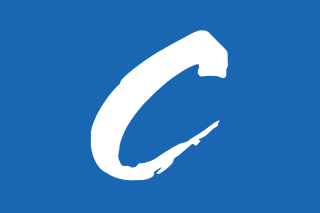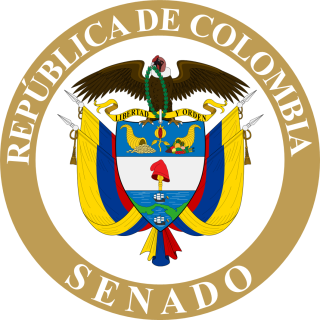The history of Colombia includes the settlements and society by indigenous peoples, most notably, the Muisca Confederation, Quimbaya Civilization, and Tairona Chiefdoms; the Spanish arrived in 1499 and initiated a period of conquest and colonization, most noteworthy being Spanish conquest of the Muisca; ultimately creating the Viceroyalty of New Granada, with its capital at Bogotá. Independence from Spain was won in 1819, but by 1830 the "Gran Colombia" Federation was dissolved. What is now Colombia and Panama emerged as the Republic of New Granada. The new nation experimented with federalism as the Granadine Confederation (1858), and then the United States of Colombia (1863), before the Republic of Colombia was finally declared in 1886. Panama seceded in 1903. Since the 1960s, the country has suffered from an asymmetric low-intensity armed conflict, which escalated in the 1990s, but then decreased from 2005 onward. The legacy of Colombia's history has resulted in one of the most ethnically and linguistically diverse countries in the world giving rise to a rich cultural heritage; while varied geography, and the imposing landscape of the country has resulted in the development of very strong regional identities.

Andrés Pastrana Arango was the 30th President of Colombia from 1998 to 2002, following in the footsteps of his father, Misael Pastrana Borrero, who was president from 1970 to 1974. As of 2017, he is the last president to come from the Conservative Party.

The Colombian Conservative Party is a conservative political party in Colombia. The party was formally established in 1849 by Mariano Ospina Rodríguez and José Eusebio Caro.

Gustavo Rojas Pinilla was the 19th President of Colombia from June 1953 to May 1957. An Army General, he mounted a successful coup d'état against the incumbent President, Laureano Gómez Castro (1889—1965), imposing martial law and establishing a dictatorship-style government in Colombia.

Horacio Serpa Uribe is a Colombian lawyer, politician and current Senator of Colombia. Serpa has run as the Colombian Liberal Party candidate for President of Colombia on three occasions; in 1998, 2002, and 2006. He previously served as congressman for Santander as Senator, Inspector General of Colombia, president of the National Constituent Assembly, Minister of the Interior, and as Ambassador of Colombia to the Organization of American States. He was also involved in the 8000 process scandal in which money from the Cali Cartel entered the presidential campaign of Liberal candidate Ernesto Samper. In 2007 Serpa ran for the governorship of Santander Department and was elected on October, 28 in the Colombian regional elections.

Presidential elections were held in Colombia on 26 May 2002. Álvaro Uribe, the candidate of the recently created Colombia First movement, was elected, receiving 54% of the vote by the first round. Uribe took office on 7 August.
National Front was a period in the history of Colombia in which the two main political parties, the Liberal Party and the Conservative Party, agreed to rotate power, intercalating for a period of four presidential terms. The National Front Presidents were Alberto Lleras Camargo (Liberal), Guillermo León Valencia (Conservative), Carlos Lleras Restrepo (Liberal), and Misael Pastrana Borrero (Conservative).

Jaime Bateman Cayón aka el flaco "Skinny" or Pablo by his fellow guerrilleros was a Colombian guerrilla leader and both founder and commander of the 19th of April guerrilla movement.
The Great Alliance for Change was a political alliance between parties in Colombia during the Colombian presidential election, 1998 that supported the presidency of Andres Pastrana Arango against the campaign of Colombian Liberal Party presidential candidacy of Horacio Serpa, back then supported by the Presidency of Ernesto Samper.

Presidential elections were held in Colombia on 27 May 1990. In an election tarnished by violence, the result was a victory for César Gaviria of the Liberal Party, who received 48.2% of the vote.

The National Popular Alliance or ANAPO was a political party in Colombia. It was founded in 1961 as a movement by the ex-president Gustavo Rojas Pinilla and was disbanded in 1998. Many ANAPO leaders and militants joined the Independent Democratic Pole coalition.

Presidential elections were held in Colombia on 6 May 1962. Under the National Front agreement, it was the turn of the Conservative Party to govern. The result was a victory for Guillermo León Valencia, who received 84% of the valid votes.

Parliamentary elections were held in Colombia on 16 September 1951 to elect the Senate and Chamber of Representatives. Although the Liberal Party boycotted the elections, some Liberals from the Populares faction did stand. As a result of the boycott, the seats reserved for the minority party were left vacant, whilst the Conservative Party won the remainder.

Parliamentary elections were held in Colombia on 16 March 1958 to elect the Senate and Chamber of Representatives. They were the first elections held under the National Front agreement, which only allowed the Conservative Party and the Liberal Party to contest the elections, and allocated 50% of the seats in both houses to each party. As a result, the main contest at the elections was between factions within each party.

Parliamentary elections were held in Colombia on 20 March 1960 to elect the Chamber of Representatives. Under the National Front agreement, only the Conservative Party and the Liberal Party were able to contest the elections, with 50% of the seats in both houses allocated to each party. As a result, the main contest at the elections was between factions within each party.

Parliamentary elections were held in Colombia on 18 March 1962 to elect the Senate and Chamber of Representatives. Under the National Front agreement,only the Conservative Party and the Liberal Party were allowed to contest the elections, with each party allocated 50% of the seats in both houses. As a result, the main contest at the elections was between factions within each party.

Parliamentary elections were held in Colombia on 15 March 1964 to elect the Chamber of Representatives. Under the National Front agreement, only the Conservative Party and the Liberal Party were able to contest the elections, with 50% of the seats in both houses allocated to each party. As a result, the main contest at the elections was between factions within each party.

Parliamentary elections were held in Colombia on 20 March 1966 to elect the Senate and Chamber of Representatives. Under the National Front agreement,only the Conservative Party and the Liberal Party were allowed to contest the elections, with each party allocated 50% of the seats in both houses. As a result, the main contest at the elections was between factions within each party.

General elections were held in Colombia on 21 April 1974 to elect the President, the Senate and the Chamber of Representatives. They were the first elections after the end of the National Front agreement, which had restricted electoral participation to the Conservative Party and the Liberal Party, with each party allocated 50% of the seats in both houses, whilst the Presidency alternated between the two parties.












